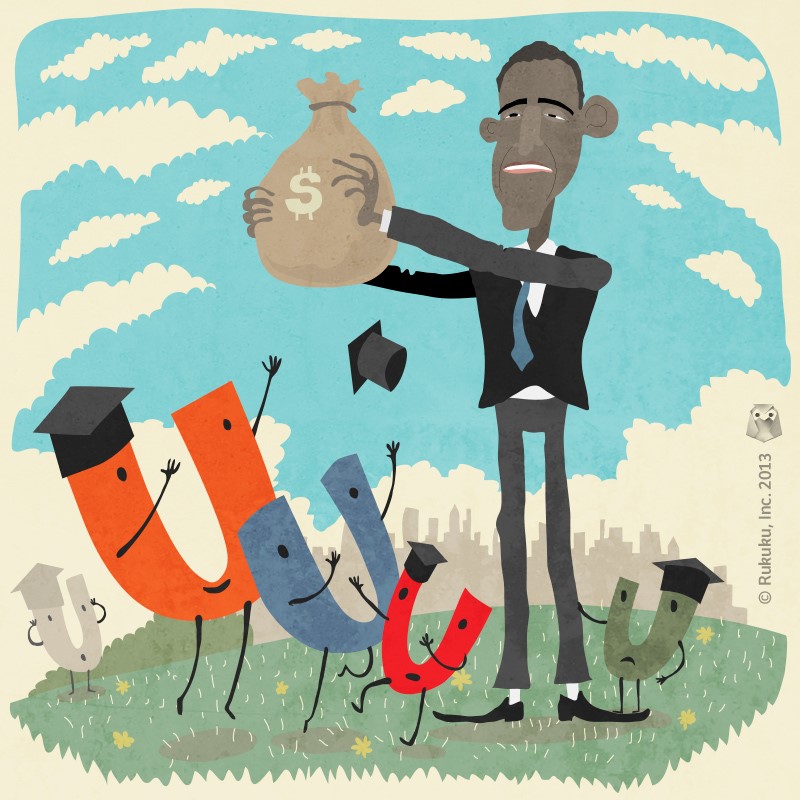New opportunities exist for students at non-traditional educational suppliers, such as Rukuku, to earn credit for their studies. It doesn’t take an economics degree to see the benefits. Take a look at this comparison in our infographic of the week.
Category Archives: higher education
Rank and File: Education Reform and College Ranking
In our most recent posts, we looked at Obama’s proposed higher education reform and its provisions for limiting student loan payments and in some cases forgiving debts. Those policies are relatively straight forward, despite a few challenges we highlighted.
The most central and more complicated part of Obama’s education plan relates to its college ranking system. For this, the Department of Education will rank universities and colleges based on several factors including graduation rate, loan default rate, average debt loads, and graduate employment rates.
Eventually, these rankings will influence the awarding of federal money for student tuition. In other words, schools that offer better deals for students will get more investment from the federal government.
It sounds reasonable enough for an investor to evaluate the potential returns. In this case, that investor is the federal government, on the one hand, and the incoming student, on the other. In both cases, knowing more about these rates should be important. This reform will make that information widely available, something that is not the case currently, as we’ve discussed in previous posts.
The more challenging part of the ranking process will be determining the proper weight of each element of the criteria without making them vulnerable to manipulation or disadvantaging schools that may be doing good things that are tougher to quantify. For example, low income students, even those with high test scores, are less likely to complete college.
Check out this graphic below, taken from this excellent 2012 blog post by Elise Gould, of the Economic Policy Institute: http://www.epi.org/blog/college-graduation-scores-income-levels/
Colleges then will have to weigh the advantages given in the ranking to assisting low-income students against the disadvantages of a possible decrease in the graduation rate. That could discourage universities from recruiting lower income students or really any students with higher risks of dropping out.
This doesn’t have to be the case, but the Department of Education must be careful when it evaluates and assigns values to the various pieces of the magical equation that will determine rankings.
That being said, the most influential aspect of this plan, at least early on, will likely be its emphasis on transparency. It is important to have this information easily available and just as important that colleges are aware that it is easily available. That will give them incentive to improve in these categories.
Taking the next step, though, and using that information to come up with a specific rank for each school could result in some unintended consequences, especially when tied directly to funding. Schools will have strong incentives to massage their numbers, and the Department of Education must be very careful to minimize the possibilities for them to do so.
To Borrow is Human; to Forgive, Divine.
In our last post, we talked about Obama’s plan to cap student loan payments at 10% of monthly income. Today we’re looking at another part of program, the loan forgiveness clause. When student debt payments drag on until the 20 year mark, the government automatically erases the debt. For those working in the public sector, the government takes over the debt after 10 years.

Uncle Sam forgives the remaining student loan debt after ten years for those working in the public sector.
The challenge with such a program is, as with anything anywhere, preventing people from taking advantage of the rules. Politico brought one such case to light recently, related to the 10 year forgiveness plan for public sector employees. Law schools at Georgetown and other universities advertised programs requiring no student loan payments ever, partly because of government programs.
In a sense, it is a generous program. Georgetown offers to make ten years of loan payments for law graduates that work in the public sector. But then, the government takes care of the rest, and this is even advertised on the program website. Check it out here. https://www.law.georgetown.edu/admissions-financial-aid/office-of-financial-aid/lrap/LRAP-III.cfm
With income-based payments, borrowers obviously make less progress on the underlying principal, meaning a larger amount is still outstanding after ten years. For professional school graduates, that amount can easily reach beyond $100,000.
For reference, here’s the politico story: http://www.politico.com/story/2013/08/law-schools-devise-debt-free-path-to-degree-95391.html
It is not quite as scandalous as an iPhone pic of a private part, but it is hard to believe this is what lawmakers were hoping for when they passed the original law in 2007 or when Obama shortened the time limits and lowered the income caps last year. (nor what Apple was hoping for when it created the iPhone).
When the government caps the payments at 10% of income, one would assume it is the borrower making those 10% payments, not their former university or anyone else. Does that count as extra income, for example? If so, do they have to recalculate the 10%? This is only one case, of course, and not an egregious one, but my guess is there will be more, especially as the program expands.
All that being said, an average participant in the program does get a lighter load in leaner times and still has responsibility for the loan. That’s what the program should do. Graduates don’t get out of the debt by making lower payments. They just extend the amount of time they will be paying on the loan, which of course means more interest payments long term. But they get a break, when they need it.
While the government will forgive the loan after 20 years (10 years in the public sector, as I mentioned above), 20 years of paying 10% of your income and still being in debt does not seem like getting off that easily. People are creative, though. Going forward, we’ll see how many more stories come up involving imaginative ideas for offloading loans at that ten or even twenty year mark. Feel free to share any such ideas in the comments section.
In our next post, we’ll look at the cost control aspects of Obama’s plan.



